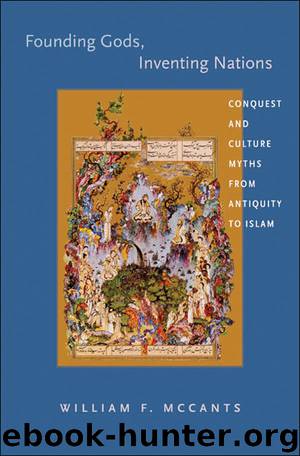Founding Gods, Inventing Nations by Mccants William; McCants William F. F.; McCants William F

Author:Mccants, William; McCants, William F. F.; McCants, William F.
Language: eng
Format: epub
Publisher: Princeton University Press
Published: 2012-04-17T04:00:00+00:00
BEROSSUS
One of the first native authors to try his hand at writing a history of local civilization in the Hellenistic age was a Chaldean priest named Berossus (d. after 278 BC), an acolyte of the Babylonian high god Marduk. Berossus, who wrote a history of Babylonia in Greek, was born during the rule of Alexander over Babylon and served his Seleucid successors, probably in the Great Temple of Esagila in Babylon.37 There are also reports of a Berossus who left Babylon and settled in Kos, an island in the Mediterranean off the coast of modern Turkey, where he established a school for astronomy or astrology. Modern scholars are split over whether or not this is the same Berossus.38
As a priest, Berossus had the ability to read cuneiform documents, a skill that was quickly fading as Greek and Aramaic, written in two noncuneiform scripts, came to dominate as literary languages after Alexander’s conquest.39 This would have given him access to the ancient temple records in Esagila.40 Berossus was also fluent in Greek, which would have made him a very valuable cultural interpreter in the polyglot court of the Seleucid Empire41 and well positioned to explain the Babylonian past to the region’s new rulers;42 hence the dedication of the book to Antiochus I around 280 BC.43
Berossus begins his narrative of Babylonian history not with a cosmogony and anthropogony, but with a framing story about a sea creature, Oannes, who gives humans all the culture they would ever need (see below). Oannes then tells humans about the origins of the world and its creatures. The universe, Oannes tells the Babylonians, “was only darkness and water.” In the darkness and water were “wondrous beings with peculiar forms who were able to engender other living beings.” These “other living beings” were either hybrids of humans and animals or of two animals. All of these creatures lived in the darkness and water, which was actually a goddess named Thalatth (Tiamat).44
After this point in Berossus’s narrative, things become a bit confused. There are two stories of the rebellion of the god Bel (Marduk),45 but it is unclear if Berossus authored both or if one is a later addition. The essence of the story is basically the same: Bel rebels against Thalatth and cuts her in half. As a result, all of the creatures inside her are destroyed. Out of her first half, Bel fashions the earth, and from her second half he makes the heavens. One of the gods then cuts off his own head.46 In the first version, the other gods mix the headless god’s blood with the earth and create humans. In the second version, the headless god mixes his own blood with the earth, creating humans and animals.
Even more important than the slight differences in the story is the commentary that is present in the first version but is absent in the second. In the first version, the author writes that the story of the headless god “is an allegorical explanation” meant to explain
Download
This site does not store any files on its server. We only index and link to content provided by other sites. Please contact the content providers to delete copyright contents if any and email us, we'll remove relevant links or contents immediately.
| Africa | Americas |
| Arctic & Antarctica | Asia |
| Australia & Oceania | Europe |
| Middle East | Russia |
| United States | World |
| Ancient Civilizations | Military |
| Historical Study & Educational Resources |
Empire of the Sikhs by Patwant Singh(22767)
The Wind in My Hair by Masih Alinejad(4843)
The Templars by Dan Jones(4558)
Rise and Kill First by Ronen Bergman(4545)
The Rape of Nanking by Iris Chang(4023)
12 Strong by Doug Stanton(3419)
Blood and Sand by Alex Von Tunzelmann(3055)
The History of Jihad: From Muhammad to ISIS by Spencer Robert(2506)
Babylon's Ark by Lawrence Anthony(2431)
The Turkish Psychedelic Explosion by Daniel Spicer(2245)
Gideon's Spies: The Secret History of the Mossad by Gordon Thomas(2235)
No Room for Small Dreams by Shimon Peres(2235)
Inside the Middle East by Avi Melamed(2230)
Arabs by Eugene Rogan(2193)
The First Muslim The Story of Muhammad by Lesley Hazleton(2154)
Bus on Jaffa Road by Mike Kelly(2035)
Come, Tell Me How You Live by Mallowan Agatha Christie(2026)
Kabul 1841-42: Battle Story by Edmund Yorke(1921)
1453 by Roger Crowley(1880)
